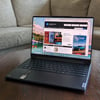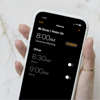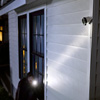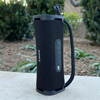Summertime means road trips and typically rising gas prices. Yet, while the fuel efficiency of your vehicle matters most, choices you make while driving, including driving style and route, can boost fuel economy by up to 45 percent, according to a recent University of Michigan Transportation Research Institute (UMTRI) study. So visit the pump less often and save money when you do by maintaining your vehicle, picking an eco-friendly route, driving with fuel economy in mind and finding the best fuel prices. You may even become a better driver along the way.
Driving Style
Citing the tips offered by the U.S. Department of Energy’s fueleconomy.gov website, UMTRI endorses the tried-and-true practices offered in the site’s Driving More Efficiently section and Planning and Combining Trips section, including using cruise control to maintain a steady speed, avoiding excessive idling and devising the best way to combine multiple destinations in a single route.
Picking the Best Route
Sitting idle in traffic costs U.S. drivers, on average, $144.50 per year or $12.04 per month, according to data released last February by INRIX, a supplier of real-time traffic information to navigation devices and apps. This is based on the fact that the average driver wastes upwards of 34 hours stuck in traffic jams––double that in New York or Los Angeles––and an hour idling equates to one gallon of lost fuel, says Jim Bak, a spokesman for INRIX. That's assuming the price of gasoline to be $4.25 a gallon, when some have estimated that gasoline this summer could spike to $5 or $6 per gallon.
The most gas is consumed while accelerating from a stop or braking, so the worst fuel economy will be had in stop-and-go traffic or along routes with many turns (which require slowing down or perhaps stopping in advance). So using an app like the INRIX Traffic app for iPhone and Android smartphones, which provides real-time traffic information and also predicts traffic along a route, can save fuel. INRIX Traffic can be used to plan the best time to travel for avoiding bottlenecks.
Beyond the real-time traffic services found in many brands of navigation devices and apps, there are other fuel-saving routing options. For example, all Magellan RoadMate navigation devices offer an “optimize route” function for multi-destination trips that calculates the fastest route over the shortest overall distance, explains Bill Strand, senior product marketing manager at Magellan.
Some Garmin navigation devices offer an optional feature named ecoRoute that provides a “less fuel” routing choice. This calculates a route based on predicted fuel consumption, which is figured using historical speed data provided by mapmaker NAVTEQ as well as assumed acceleration and deceleration patterns for the roads to be traveled (based on the number of stops and turns as well as average speeds), says Johan-Till Broer, a spokesman for Garmin. The optimal speed for fuel efficiency is between 45 and 55 MPH, Broer says.
Also part of Garmin’s ecoRoute feature are a Fuel Report, which tracks fuel usage over time, and a Mileage Report, which monitors mileage and fuel usage on a per-trip basis. These calculations are based on a stored “vehicle profile” that includes the vehicle’s fuel economy and a price per gallon for fuel, both saved to the device by the user. A Driving Challenge monitors how aggressively you drive along your current route and assigns you a fuel efficiency score from 0 (worst) to 100 (best).
The ecoRoute feature costs $9.99 and is activated through an online purchase at Garmin's website. In Garmin's 2012 collection, ecoRoute is available only for the 2xx5, 34xx and 35xx models, Broer says.
Maintaining Your Vehicle
Devices that plug into a special port found in all automobiles built since 1996––called OBD II and usually found below the steering wheel––can retrieve vehicle diagnostics and performance data such as throttle position and engine load from the vehicle’s electronic systems.This data can be used for better routing and identifying vehicle problems that may not pose an immediate risk but could be costing you at the pump.
Garmin sells an OBD II accessory for the ecoRoute-compatible nüvi navigation devices, named Garmin Mechanic with ecoRoute HD ($93.80 on Amazon.com). The data it collects is sent to the navigation device from the device (via a Bluetooth connection), which makes for precise results in the various ecoRoute reports and the Driving Challenge, which otherwise utilize navigation device-generated estimates of speed, acceleration and braking based on GPS positioning data.
Moreover, some of the data monitored by the Garmin Mechanic accessory identifies vehicle problems that have set off the “Check Engine” light and may affect fuel economy without posing any other immediate risk.
For example, a failing oxygen sensor will trigger the check engine light and will reduce fuel economy by up to 40 percent, says Art Jacobsen, vice president at CarMD.com Corp., which sells its own device ($98.56 on Amazon.com) that plugs into the OBD II port. It identifies both hidden problems that may trigger the Check Engine light in the future as well as those that already have done so. One such hidden problem that lowers fuel economy could be a faltering knock sensor, which would trigger a warning from the CarMD device but would not trigger the Check Engine light, Jacobsen says. A failed knock sensor could reduce fuel economy at least two to five percent, Jacobsen says.
The CarMD device is a stand-alone unit with its own display and warning lights to identify all vehicle powertrain problems communicated via the OBD II port.
Using Gas Apps
Gasonomic (free in iTunes) is an app filled exclusively with gas-saving tips, ranging from the fairly obvious (keep tires properly inflated) to the esoteric (don’t fly flags outside your car’s windows) and the possibly ridiculous (consider walking instead of driving). Automaker Buick's Fuel Efficiency Games app (free in iTunes and Google Play) for iPhone and Android smartphones––ostensibly meant to promote Buick’s hybrid cars––contains three mini games that purport to teach players the tricks of “hypermilers,” or people whose driving style is tailored to maximizing fuel efficiency.
Ultimately, though, what's even better than stretching the miles between fill-ups is shrinking the cost of those fill-ups. For that, check out GasBuddy (free for Android, iPhone, Windows Phone and BlackBerry) or SmartFuel (app is free in iTunes, but requires $2.99 per year subscription).















From Teh CSiang on May 17, 2012 :: 11:57 am
Other than the tips that is well known, It is important NOT TO fill full tank all the time. To prevent spilling of overflow petrol, the pump mechanism will return any fuel that cannot be filled back into the gas pump, however the meter will charge the full amount of money.
Reply